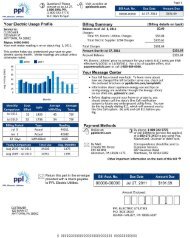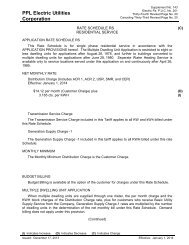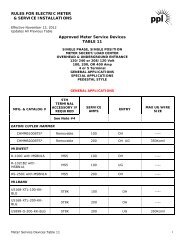How PPL Calculates Customer PLCs - PPL Electric Utilities
How PPL Calculates Customer PLCs - PPL Electric Utilities
How PPL Calculates Customer PLCs - PPL Electric Utilities
Create successful ePaper yourself
Turn your PDF publications into a flip-book with our unique Google optimized e-Paper software.
2013 <strong>PPL</strong> <strong>Electric</strong> <strong>Utilities</strong> Corporation<br />
<strong>PPL</strong> <strong>Electric</strong> <strong>Utilities</strong><br />
Peak Load Contribution<br />
Calculation Methodology
Conceptual Overview<br />
• Peak Load Contribution (PLC)<br />
• Assigning a value for each customer’s typical contribution to a typical peak load<br />
day.<br />
• Initially allocated out to the customers that existed at the time of the 5 peak loads.<br />
• Default values used for new load based on the average PLC in each rate class.<br />
• The values are adjusted where better information suggests a more appropriate value.<br />
• Purpose is to allocate responsibility to suppliers for the recovery of:<br />
• Capacity cost from the PJM RPM auction<br />
• Revenue requirements for transmission facilities in the <strong>PPL</strong> Zone<br />
2013 <strong>PPL</strong> <strong>Electric</strong> <strong>Utilities</strong> Corporation 2
Capacity PLC<br />
• Defined in the Reliability Assurance Agreement (RAA)<br />
• Calculated in November/December<br />
• Applied from June 1 st to May 31 st of the next year.<br />
• Based on the PJM peak allocated to <strong>PPL</strong> Zone<br />
• The <strong>PPL</strong> Zone peak was the <strong>PPL</strong> Zone share of the load that was the basis for<br />
the amount of capacity purchased in the PJM capacity auctions (eRPM).<br />
• <strong>PPL</strong> Zone allocation is calculated by PJM<br />
• The PJM peak is weather normalized and adjusted for interruptions.<br />
• Allocation to the customers based on PJM 5 Coincident Peaks (5CP method)<br />
• <strong>Customer</strong> <strong>PLCs</strong> are based on the 5 peaks from prior year<br />
• October 1 st – September 30 th<br />
• Typically these are 5 Summer Peaks<br />
• Allocation is to provide the customer’s average contribution to a typical PJM peak<br />
load day.<br />
2013 <strong>PPL</strong> <strong>Electric</strong> <strong>Utilities</strong> Corporation 3
Transmission PLC<br />
• Defined in the PJM Open Access Transmission Tariff (OATT).<br />
• Calculated in November/December<br />
• Applied from January 1 st to December 31 st of the next year.<br />
• Based on the <strong>PPL</strong> Zone metered peak from the prior year<br />
• The <strong>PPL</strong> Zone peak was the <strong>PPL</strong> Zone load from the prior year that was the basis<br />
for the Network Integration Transmission Service (NITS) charge for the <strong>PPL</strong> Zone.<br />
• The <strong>PPL</strong> Zone peak is the metered peak and is not weather normalized nor adjusted for interruptions.<br />
• Allocation to the customers based on <strong>PPL</strong> Zone 5 Coincident Peaks (5CP method)<br />
• <strong>Customer</strong> <strong>PLCs</strong> are based on the 5 peaks from prior year<br />
• November 1 st – October 31 st<br />
• <strong>PPL</strong> Zone peaks vary between summer and winter.<br />
• Allocation is to provide the customer’s average contribution to a typical <strong>PPL</strong> Zone<br />
peak load day.<br />
2013 <strong>PPL</strong> <strong>Electric</strong> <strong>Utilities</strong> Corporation<br />
4
Use of Interval Load Data for All <strong>Customer</strong>s<br />
• Beginning in 2011 <strong>PPL</strong> calculates each customer PLC values based<br />
on the interval load data for the 5CPs.<br />
• Starting with the calendar year 2010, <strong>PPL</strong> <strong>Electric</strong> <strong>Utilities</strong> had interval data<br />
available for all of its customers.<br />
• This allows <strong>PPL</strong> to calculate each customer’s PLC based on their actual<br />
contribution to the 5 peak load days/hours.<br />
2013 <strong>PPL</strong> <strong>Electric</strong> <strong>Utilities</strong> Corporation<br />
5
PLC Calculation<br />
• Each customer load for the day/hour of the 5CPs will be adjusted for:<br />
• Losses based on the customer service level associated with their rate class.<br />
• These loss factors are those stated in the <strong>PPL</strong> <strong>Electric</strong> <strong>Utilities</strong> Supplier Coordination Tariff.<br />
• Adjustment to the target load value for <strong>PPL</strong> Zone (Reconciliation Factor)<br />
• The generation level load (meter load + losses) for every customer is summed.<br />
• A reconciliation factor is then determined by dividing the target load by the sum of the metered load +<br />
losses.<br />
• The reconciliation factor is then applied to each of the customer’s load plus losses, to determine their<br />
daily responsibility for the capacity or transmission requirement each day.<br />
• The 5 adjusted peak loads for each customer are then averaged to create the<br />
customer’s PLC.<br />
2013 <strong>PPL</strong> <strong>Electric</strong> <strong>Utilities</strong> Corporation<br />
6
<strong>PPL</strong> <strong>Electric</strong> <strong>Utilities</strong> PLC Calculation Method<br />
Below is a 10 meter example of the PLC calculation.<br />
Rate Class/Meter Metered Load w/ Losses Reconciled Meter Load w/ Losses PLC PLC for<br />
Peak Load<br />
Values w/<br />
Peak<br />
1<br />
Peak<br />
2<br />
Peak<br />
3<br />
Peak<br />
4<br />
Peak<br />
5<br />
Peak<br />
1<br />
Peak<br />
2<br />
Peak<br />
3<br />
Peak<br />
4<br />
Peak 5 (Average) Active<br />
Meters<br />
Losses<br />
A1 0.5 0.4 0.3 0.3 0.4 0.5 0.4 0.3 0.3 0.4 0.4 0.4<br />
A2 Retired Meter 1.4 1.3 1.2 1.4 1.4 1.3 1.4<br />
A3 0.7 0.5 0.9 0.8 0.9 0.7 0.5 0.9 0.8 0.9 0.8 0.8<br />
B4 3.5 3.5 3.5 3.5 2.4 3.5 3.8 3.7 3.4 2.5 3.4 3.4<br />
B5 New Meter 8.2 8.2 8.5 8.6 8.0 8.8 8.4 8.4<br />
B6 New Meter<br />
(after 5CPs)<br />
Default<br />
5.1<br />
B7 4.7 3.5 3.5 3.5 2.4 4.7 3.8 3.7 3.4 2.5 3.6 3.6<br />
C8 23.7 23.7 22.1 22.7 25.5 23.8 25.8 23.1 22.1 26.3 24.2 24.2<br />
C9 Meter 1 108.9 109.0 109.6 118.5 114.0<br />
C9 Meter 2<br />
108.9 110.0 110.5 113.8 107.3 114.1 111.7 112.6<br />
(Replaced Meter 1)<br />
C10 35.5 23.7 23.7 35.5 23.7 35.7 25.8 24.8 34.6 24.5 29.1 29.1<br />
Total 178.9 165.6 172.3 184.5 174.3 180.0 180.0 180.0 180.0 180.0 297.0 187.7<br />
Target Load 180.0<br />
Reconciliation<br />
Factor 1.01 1.09 1.04 0.98 1.03<br />
B Class<br />
Default 5.1<br />
The 10 meters in above example represent meters in 3 rate classes (secondary, primary, and transmission level rate classes).<br />
The values shown are assumed to already be adjusted for the losses associated with their service level.<br />
2013 <strong>PPL</strong> <strong>Electric</strong> <strong>Utilities</strong> Corporation<br />
7
Unforced Capacity Obligation (UCO)<br />
• The Capacity PLC is the load plus losses value provided to suppliers<br />
for each customer they serve. It does not include any reserves.<br />
• Each day <strong>PPL</strong> provides to PJM the aggregated Capacity PLC for all<br />
of the suppliers customers rounded up to the next highest tenth of a<br />
megawatt.<br />
• PJM then adjusted the supplier’s aggregated PLC value by:<br />
• First scaling each supplier’s PLC so that the sum of all suppliers <strong>PLCs</strong> in the <strong>PPL</strong><br />
Zone equals the <strong>PPL</strong> Zone Target.<br />
• This scaling factor changes daily as new customers are added and dropped in the <strong>PPL</strong> Zone.<br />
• And a second scaling factor that includes:<br />
• the PJM Forecast Pool Requirement (FPR) which added the suppliers share of the reserve capacity<br />
purchased in the auction), and<br />
• an adjustment to reflect difference in ILR purchased through the RPM not assumed in the capacity<br />
obligation used for the PJM auction.<br />
• The product of the aggregated capacity <strong>PLCs</strong> and the scaling factors is the<br />
suppliers UCO.<br />
2013 <strong>PPL</strong> <strong>Electric</strong> <strong>Utilities</strong> Corporation 8
Do We Make Changes to Assigned PLC Values?<br />
• A PLC value is intended to be a measure of the amount of<br />
generation or transmission capacity that <strong>PPL</strong> must secure or build to<br />
serve the customer.<br />
• It is based on the customer share of the system’s typical peak load.<br />
o The prior year value is the basis for the capacity secured for the next year.<br />
• On this basis the value of the PLC once assigned is considered fixed and is not<br />
changed as the customer load and demand changes.<br />
o It is not increased in the customer load goes up, nor<br />
o is it decreased if the customer load goes down.<br />
o It will increase of decrease in the following year.<br />
• A PLC value will be corrected if it is found to be in error due to:<br />
• Missed Peaks<br />
• Meter or Account number changes<br />
• Meter error or failures<br />
• Etc.<br />
2013 <strong>PPL</strong> <strong>Electric</strong> <strong>Utilities</strong> Corporation 9
Assignment of PLC to New Large C&I <strong>Customer</strong>s<br />
• The assignment of PLC to a new Large C& I <strong>Customer</strong> is done based on<br />
input from:<br />
• <strong>Customer</strong> provided estimate of their expected demand for the next summer<br />
• <strong>PPL</strong> <strong>Electric</strong> <strong>Utilities</strong> Key Account Manager (KAM) estimation of the customer demand<br />
(Engineering reports, anticipated diversity, etc.)<br />
• Rate at which the new load will be ramping up.<br />
o What do they think their demand will be by mid summer (July)?<br />
o Is the load being transferred from a prior facility?<br />
• Issues we have experienced:<br />
• Estimated demand based on equipment design for ultimate demand at the facility which the<br />
customer will not reach by mid summer …. if ever.<br />
• Ambitious construction schedules or delays in construction.<br />
• We need to be as realistic as possible of what we expect their demand to be<br />
without giving away the store.<br />
• Their supplier will be billed by PJM based on these values.<br />
• They may experience bills that seem to be outrages.<br />
• It is a start up value so we should be reasonably conservative.<br />
• Help the customer understand the impact the estimate can have on their bill.<br />
2013 <strong>PPL</strong> <strong>Electric</strong> <strong>Utilities</strong> Corporation 10
Material Available on the Supplier Website<br />
• Peak Load Contribution Information<br />
• https://www.pplelectric.com/at-your-service/for-generation-suppliers/general-supplierreference-information/peak-load-contribution-information.aspx<br />
• 2010 PJM & <strong>PPL</strong> Zone Peak Load Dates for 2011-2012 PLC Calculations (.xls)<br />
• 2011 PJM & <strong>PPL</strong> Zone Peak Load Dates for 2012-2013 PLC Calculations (.pdf)<br />
• 2012 PJM & <strong>PPL</strong> Zone Peak Load Dates for 2013-2014 PLC Calculations (.pdf)<br />
• 2012 Transmission and 2012-13 Capacity PLC Calculator (.xls)<br />
• 2013 Transmission and 2013-14 Capacity PLC Calculator (.xls)<br />
• 2013-14 <strong>PPL</strong> <strong>Electric</strong> PLC Default Values and Loss Factors (.pdf)<br />
• <strong>How</strong> <strong>PPL</strong> <strong>Calculates</strong> <strong>Customer</strong> <strong>PLCs</strong> (.pdf)<br />
• PLC Development and Application Time Table (.xls)<br />
2013 <strong>PPL</strong> <strong>Electric</strong> <strong>Utilities</strong> Corporation<br />
11

















